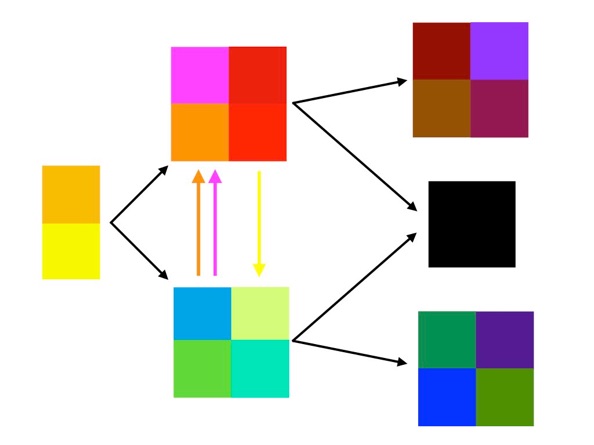Dye Rinses

Dye colors can be removed from eggs either chemically or physically. In the first case, the dye molecules remain in place on the shell, but are altered enough that they no longer reflect light. In the second case, the molecules are actually removed from the shell of the egg.
Using dye rinses is a modern technique that came about with the usage of acid/aniline dyes. Part of the dyeing process is that when using successive dye baths, you are (at least partially) replacing one dye molecule with another (reaching equilibrium). This becomes evident when you try going from a darker color (e.g. red) to a lighter one (e.g. yellow). The egg will shed some of the red dye molecules and they will be replaced with yellow ones on the egg; those red molecules will go back into solution in the jar of yellow dye the slightly change its color.
DYE RINSES:
Each successive color DOES remove its predecessor, to some extent. Obviously, yellow doesn't dye well over black. The traditional color order goes from light to dark to take advantage of this feature. Some dyes, though, can be utilized to remove colors and switch between color families.
Orange Rinse: Orange does a particularly good job of removing color, at least in part due to a lack of vinegar (UGS Orange); many pysankarky keep a separate batch of "orange rinse" just for that purpose. It is used to go form the blue/green family of dyes to red/orange.
Yellow Rinse: Yellow is not as fast as orange at removing dyes, but will do so. It is useful for moving from the Red/Orange family of dyes to the Blue Green.
Gold Rinse: UGS Gold (without vinegar) can also be used to switch from the Red/Orange family of dyes to the Blue Green. Instructions would be the same as for Yellow Rinse.
Pink Rinse: UGS Pink is said to do a great job of covering UGS Light Green.
Back to Main Dyeing page
Back to Main Advanced Dyeing page
Back to Main Pysankarstvo page
Search my site with Google


Removing Dye with Dye



